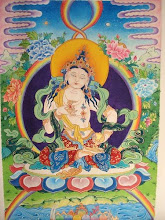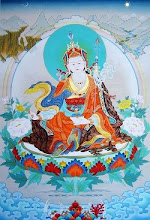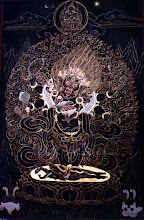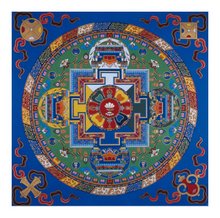Buddhist practitioners can levitate. They can see the future. When they die, their bodies turn to light.
So claims Surya Das.

I genuinely enjoyed
Awakening the Buddha Within. The book is a primer on Buddhism, with a chapter on the Four Noble Truths, and one each on the Eightfold Path, clearly explained and illustrated for the western reader making his or her first encounter with Buddhism. Surya Das' writing is breezy and conversational, an easy-to-read style that keeps you turning the pages. Das doesn't get bogged down in the minutiae of theology or philosophy and personalizes his teachings by relating relevant stories from his own life and his own search for meaning. As much "what is," the book also offers "how to" in the form of simple meditations and other exercises, such as keeping a dream journal or a creating a collection of favorite spiritual quotations, simple steps to for helping build new awareness.
As much as I liked the book, I also found some fairly outlandish claims within, such as the section on Lucid Dreaming, in which Das writes that we can multiply our bodies, travel to heavenly realms to receive special spiritual teachings, and that he himself was able through such practices to see into the future.
He sets us up early on by letting us know that such super human powers, while manifest among the Buddhist elite, are ultimately mere distractions along the path.
Seekers, curious about the unknown, might want to know more about levitation, conscious dying, lucid dreaming, astral travel, rainbow bodies, and clairvoyance. However, that's not finally what it's all about. The Buddha did perform certain miracles, but he always instructed his disciples not to demonstrate miraculous powers except to inspire faith in the skeptical. Lamas say the same thing. The magical, mysterious and occult are special effects that can be produced, but it's not the whole story. The miracle of Buddhism is a miracle of love, not levitation. [pp 12-13]
As we're only on page 12, it might be reasonable to expect some future explication of such feats, but the only thing I recall reading is a couple of paragraphs in the last quarter of the book, in the section on Lucid Dreaming.
By seizing a dream we can perform spiritual activities, multiply our bodies, as well as go to pure realms of existence to receive teachings and blessings from Buddhas, transcendent Bodhisattvas, and saintly sages. In this way we train to master altered states and different ways of being, including astral travel and other out-of-body experiences.... With guidance from my teachers, ... I was able to get some indication of future events and to understand certain signs, portents and omens. [pp 330-331]
Amazing.
Perhaps not so amazing for a Tibetan who's grown up listening to stories about such super-human feats. But Tibetans are not likely to be reading this book, at least not in large numbers. This book is for Europeans and North Americans, the people most likely on planet Earth to be skeptical - and curious - about such claims.
And yet Das provides no evidence, no proof, not even an accounting of what he experienced or what he witnessed. For over 300 pages he covers the Four Noble Truths and the Eight Fold Path, a topic that is covered by most authors in a few pages. Das' account is padded with quotations, examples, stories, and illustrations, from the lives of saints, from every day life, from his own life. But here - nothing. He falls strangely silent.
I do not claim that such feats are impossible. They certainly may be. But Das' refusal to engage the subject makes it seem he has something to hide, which in turn casts a shadow of doubt across the rest of what is a well-written introduction to Buddhism. If he can't talk to us honestly about this, then what else can't he discuss openly? What else might he be hiding?
#



































